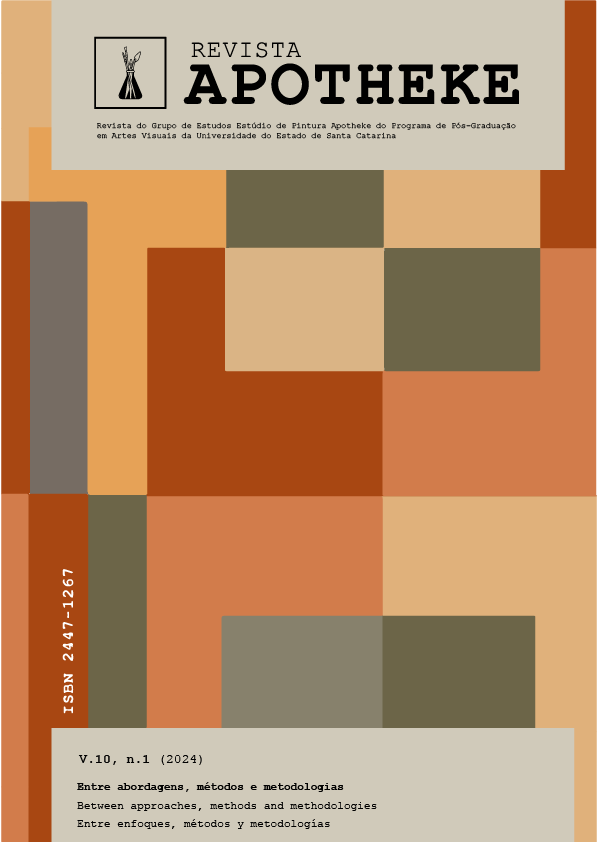The children's house: the place of art within the Occupation
DOI:
https://doi.org/10.5965/244712671012024225Keywords:
art/education, Occupation, home, dwelling, resignifyAbstract
This article presents reflections on the conception of “home” of children and adolescents who live in Ocupação Justo, in São Leopoldo, considering visual arts as an instrument for redefining social identity within the inhabited context. The field research was carried out between the months of October and November 2023, with a group of approximately 40 children and adolescents, between 7 and 17 years old, participating in the Tenda do Encontro, the Ocupação’s space for activities with the community. Based on the work carried out in the meetings, we sought to analyze the impact of art/education workshops, in order to capture and transmit the narratives underlying these occupied spaces, to become aware of the context in which they live, giving new meaning to the feeling of social belonging of the residents of that region. The practices involved the presentation of people and projects that address the houses and the feelings promoted by them, expressing their identities and the feeling of belonging, reflecting stories and realities of the occupation, they are: Marcelino Melo (Quebradinha Project), the Morrinho Project ( RJ), visual artist Mônica Nador (JAMAC Project), the African festival Bogo Ja and the Yanomami village-house. The theoretical framework that underlies the reflection included Walter Benjamin, Ana Mae Barbosa, Georges Henri Luquet and Gaston Bachelard. Reflection on the research carried out shows that young people use art education as a refuge to do what they like, in addition to having Ocupação Justo as an extension of their own homes. Furthermore, the group participating in the research demonstrated a new meaning regarding the perception of their homes, their Occupation and the context in which they live, revealing that art has an essential role in the construction of identities and its presence is essential in non-school education spaces.
Downloads
References
BACHELARD,G. A poética do espaço. São Paulo: Martins Fontes, 2000.
BARBOSA, Ana Mae. Inquietações e Mudanças no Ensino da Arte. 6a edição. São Paulo. Cortez, 2011.
GOLDBERG, Luciane; FROTA, Ana Maria Monte Coelho. O desenho infantil como escuta sensível na pesquisa com crianças: inquietude, invenção e transgressão na elaboração do mundo, 2018.
GRUBITS, Sonia. A casa: cultura e sociedade na expressão do desenho infantil, 2003 disponível em: <https://www.scielo.br/j/pe/a/hPdwKkkxp4zhrJJYpYm9sBG/?format=pdf&lang=pt >. Acesso em 01 de julho de 2022
MILLEN, João Bosco Camargo. Construir, Habitar, Pensar: Uma Proposta (re)Leitura. Poliética. São Paulo, v. 7, n. 2, pp. 119-142, 2019.
LOWENFELD, Viktor. A criança e sua arte. São Paulo: Mestre Jou, 1977.
LUQUET, G. H. O desenho infantil. Porto: Civilização, 1969.
RODRIGUES, Melissa Haag. Análise do desenho infantil segundo as ideias de Luquet 2017, disponível em: <https://ojs.unifor.br/rh/article/view/7474> . Acesso em: 1 abr. 2022.
Downloads
Published
How to Cite
Issue
Section
License
Copyright (c) 2024 Lorena Toniolo Zampetti, Denise Blanco Sant’Anna

This work is licensed under a Creative Commons Attribution-NonCommercial 4.0 International License.
Copyright and Licensing Policy
Authors of works submitted to Revista APOTHEKE authorize their publication in both print and digital formats exclusively for academic purposes. Reproduction is permitted, provided that the source is properly cited. Authors confirm the originality, authorship, and unpublished status of their manuscripts.
Articles published by the journal are freely available and intended for academic and non-commercial use only. All copyrights are transferred to the journal. The content of signed articles reflects the views of their respective authors and not the official position of Revista Apotheke. The author(s) agree to always cite the following reference when republishing or referring to the content originally published in Revista Apotheke:
“This article was originally published by Revista Apotheke in volume (insert volume), number (insert number), year (insert year), and is available at: http://www.revistas.udesc.br/index.php/APOTHEKE/index”
It is the sole responsibility of the authors to obtain written permission for the use of any material protected by copyright law included in their articles. Revista Apotheke is not responsible for copyright infringements committed by contributors.
Authors retain copyright and grant the journal the right of first publication, with the work licensed under a Creative Commons Attribution-NonCommercial License (CC BY-NC):
-
Attribution (BY): Licensees are allowed to copy, distribute, display, perform, and create derivative works, provided that proper credit is given to the author or licensor, in the manner specified.
-
NonCommercial (NC): Licensees may use the material only for non-commercial purposes.
After publication, authors retain the rights to their work and may republish the text.



